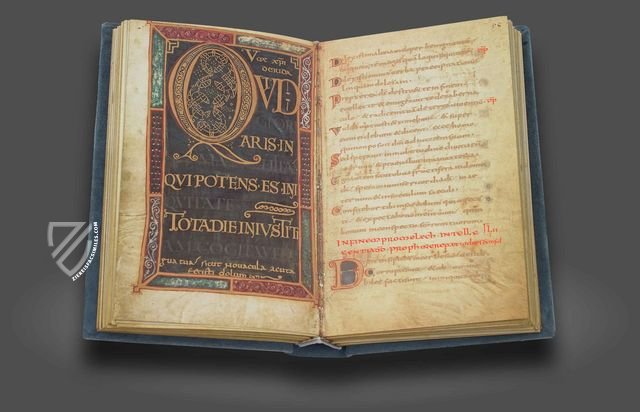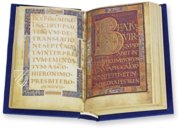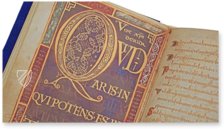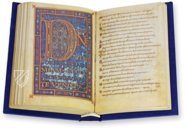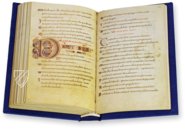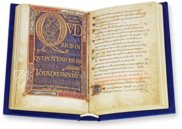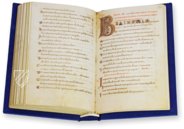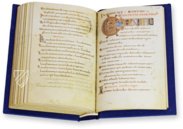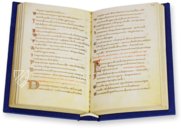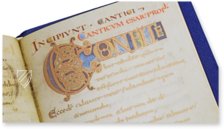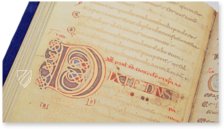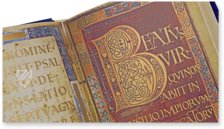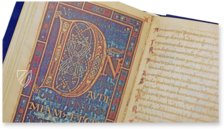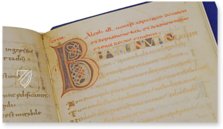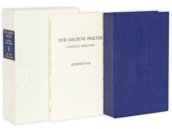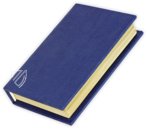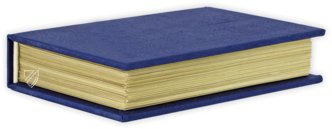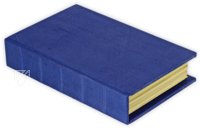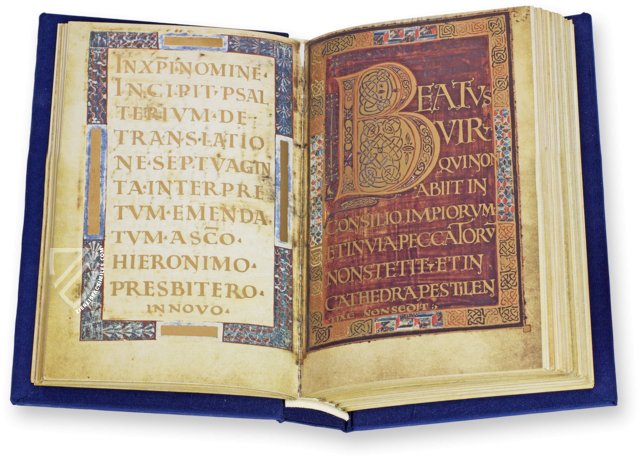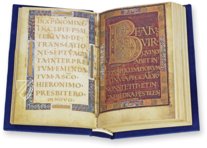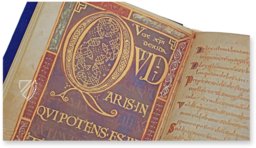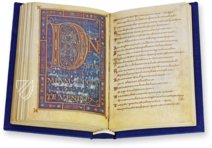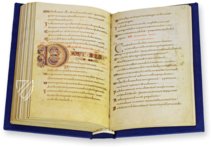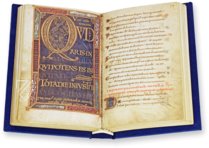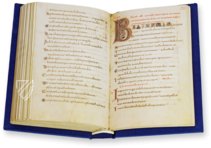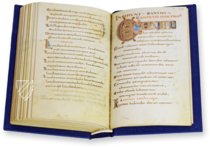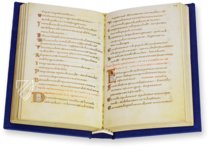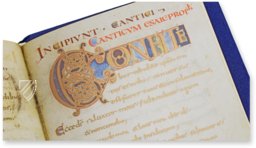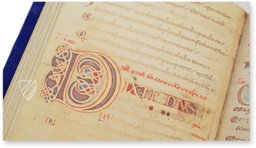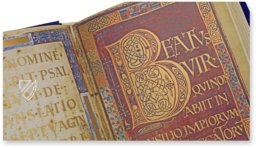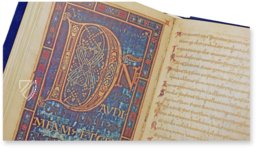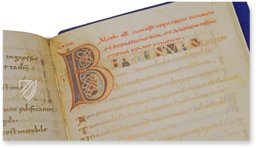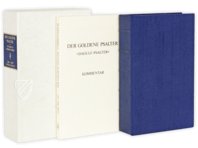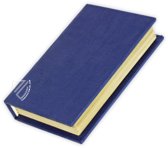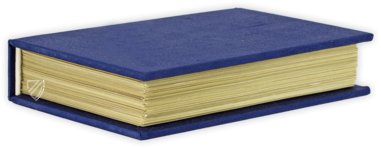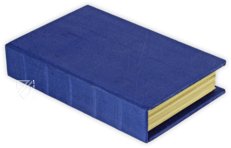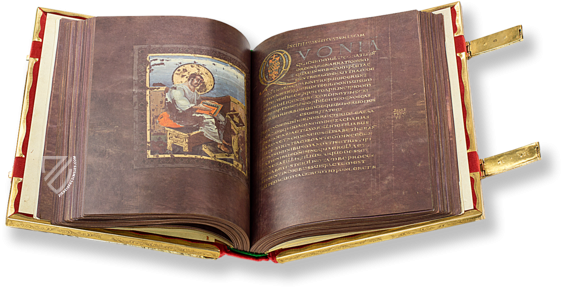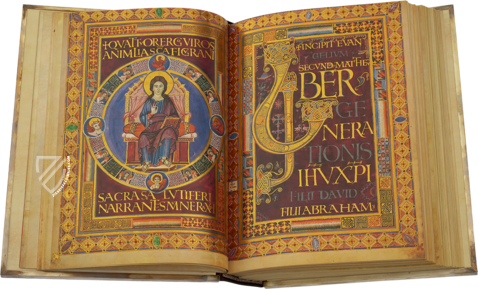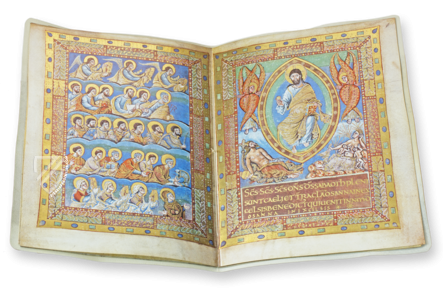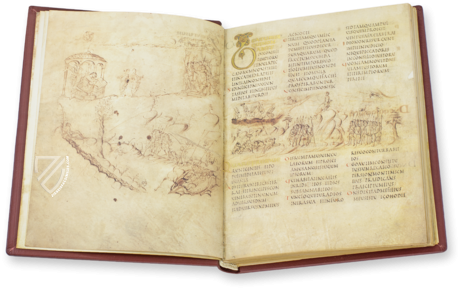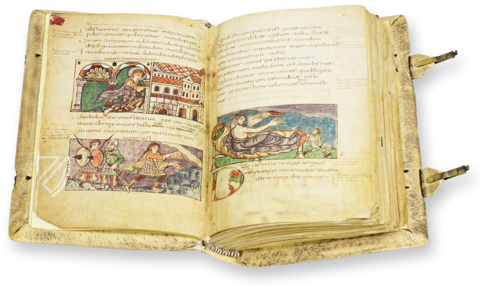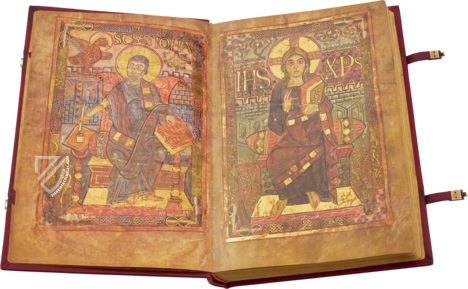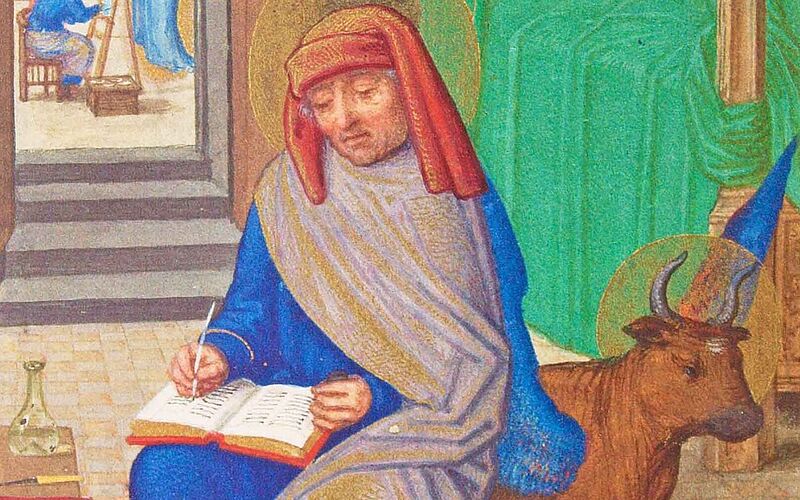Golden Psalter of Charlemagne - Dagulf Psalter
(1,000€ - 3,000€)
The Golden Psalter of Charlemagne, also known as Dagulf Psalter according to the name of the scribe who wrote it, is one of the few surviving Carolingian manuscripts that was made for personal use. A product of the so-called Palace School, work on it was begun in Worms and Metz between 783 and 789 before being finished in Aachen in 795. The Psalter may have originally been commissioned as a gift for Pope Adrian I, but it is believed that one of Charlemagne’s wives received it for her personal use. As personal manuscripts were rare in this period, particularly for lay-persons and even more so for women, this spectacular manuscript of imperial purple and gold was a particularly ostentatious sign of both power and sophistication.
Dagulf Psalter
The Golden Psalter of Charlemagne, also known as Dagulf Psalter according to the name of the scribe who wrote it, is among the regal manuscripts of the Palace School, i.e. among those jewels of illumination which were produced before the imperial coronation of Charlemagne in the year 800. The Psalter, a collection of 150 Psalms of the Old Testament, covers two decisive phases of the Carolingian school of painting. The section carried out between 783 and 789 may be identified as having been made in Worms and Metz, whereas the completion of the codex undoubtedly took place in Aachen between 790 and 795. The Golden Psalter thus constitutes a testimony to the evolution of the Palace School, which started in several places, but became fully developed after the establishment of the new capital in Aachen.
A Golden Manuscript from Charlemagne's Palace School
Both the size and design of the manuscript reveal that rather than being destined for use in public liturgy, it was intended for a private person. Who this person was remains unclear: it may have been originally intended as a gift to Pope Adrian I (r. 772–795), but he died before it was completed, and thus may have come into the possession of one of Charlemagne’s wives. Dagulf, the scribe, used a remarkable wealth of scripts to decorate his Psalter, as was customary in this period. The beautiful script undoubtedly ranks among the finest examples of early Carolingian minuscule which later played an important part in the development of the Roman script we use today. A major portion of the manuscript is referential to Dagulf who signed the book in a dedication poem to Charlemagne.
Illumination at its Very Best
All ornamental pages are lavishly executed and delight the viewer with their well-balanced harmony of colors and golden tones as well as with soft and rounded forms. A certain tension between the individual elements further enhances their charm. An element of improvisation is revealed in the frames and this playful character has contributed much to the book’s value. The predominant decorative form is the interlaced band which appears in a wide range of variations. Of all the ornamental pages, the frontispiece stands out due to its unusual coloring because it is dominated by blue tones, lacks a purple background, and the use of gold is reserved.
Codicology
- Alternative Titles
- Der Dagulf-Psalter
Goldener Psalter - Size / Format
- 324 pages / 19.1 × 12.0 cm
- Origin
- Germany
- Date
- 783–795
- Epochs
- Style
- Genre
- Language
- Script
- Carolingian minuscule Uncial Rustic capitals Square capitals
- Illustrations
- 5 ornamental pages on purple, deep blue, or steel-colored backgrounds
- Content
- Complete text of the Book of Psalms
- Patron
- Charlemagne (747–814) for his wife Hildegard
- Artist / School
- Dagulf (scribe)
Palace School of Charlemagne
Golden Psalter of Charlemagne - Dagulf Psalter
Golden “Q” Initial
This is one of the few Carolingian manuscripts that can be clearly attributed to a specific artist or scribe and is the work of an accomplished monk named Dagulf. His masterful hand is evident throughout the codex but especially on the five elaborate incipit pages, which are exemplary of Carolingian illumination. The purple background contrasts beautifully with the generous use of gold leaf, making the Insular-style interlace all the more spectacular.
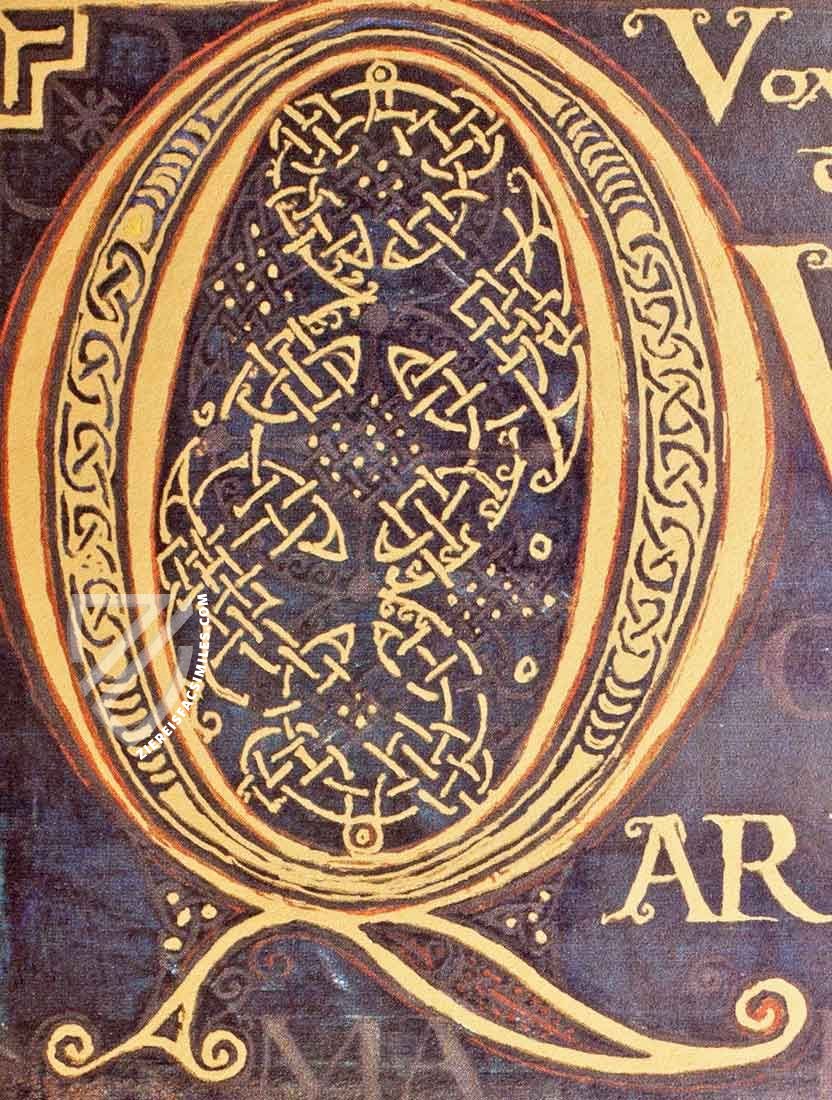
Dagulf Psalter
Incipit Page: Beatus Vir
In the Vulgate Bible, the authoritative biblical text of the Middle Ages, the Book of Psalms begins with Beatus vir… or “Blessed is the man…” These words have appeared in various illuminated manuscripts on splendidly adorned incipit pages across the Middle Ages. This Psalter, created at the behest of the Emperor Charlemagne, is both one of the earliest and finest of these specimens.
It is no surprise that this incredibly rich and refined image comes from a manuscript made for Hildegard, the wife of the Emperor Charlemagne. It is a distinctly Carolingian incipit page: a detailed initial with Insular interlace patterns, generous use of gold leaf, and a dark purple background to both contrast the gold and indicate the imperial patronage of the manuscript.
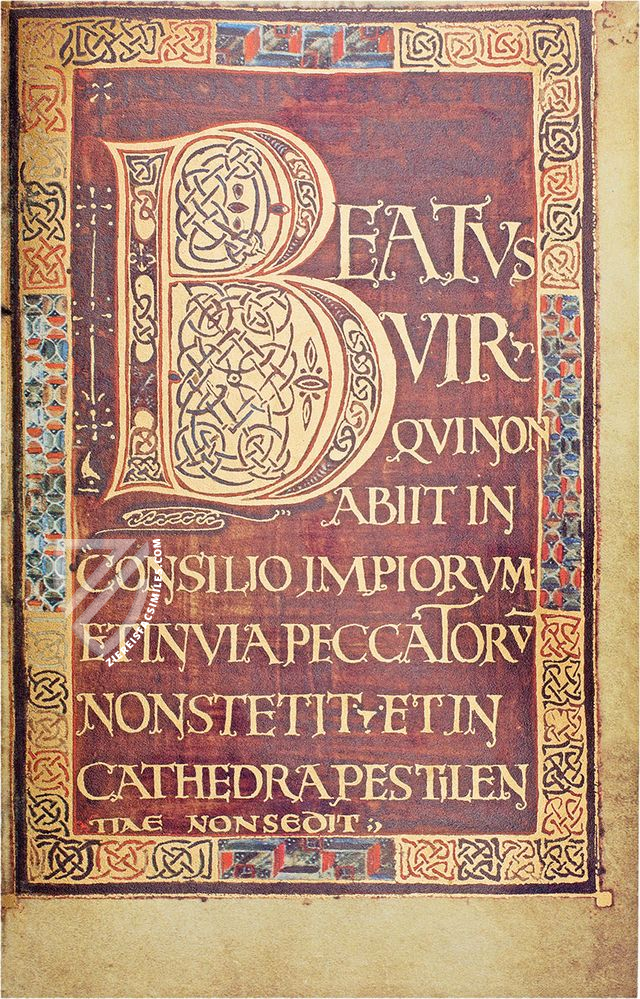
#1 Der Dagulf-Psalter (Goldener Psalter)
Language: German
The commentary volume with 100 pages introduces you to the world of Emperor Charlemagne and explains in detail the magnificent illumination.
(1,000€ - 3,000€)
- Treatises / Secular Books
- Apocalypses / Beatus
- Astronomy / Astrology
- Bestiaries
- Bibles / Gospels
- Chronicles / History / Law
- Geography / Maps
- Saints' Lives
- Islam / Oriental
- Judaism / Hebrew
- Single Leaf Collections
- Leonardo da Vinci
- Literature / Poetry
- Liturgical Manuscripts
- Medicine / Botany / Alchemy
- Music
- Mythology / Prophecies
- Psalters
- Other Religious Books
- Games / Hunting
- Private Devotion Books
- Other Genres
- Afghanistan
- Armenia
- Austria
- Belgium
- Belize
- Bosnia and Herzegovina
- China
- Colombia
- Costa Rica
- Croatia
- Cyprus
- Czech Republic
- Denmark
- Egypt
- El Salvador
- Ethiopia
- France
- Germany
- Greece
- Guatemala
- Honduras
- Hungary
- India
- Iran
- Iraq
- Israel
- Italy
- Japan
- Jordan
- Kazakhstan
- Kyrgyzstan
- Lebanon
- Liechtenstein
- Luxembourg
- Mexico
- Morocco
- Netherlands
- Palestine
- Panama
- Peru
- Poland
- Portugal
- Romania
- Russia
- Serbia
- Spain
- Sri Lanka
- Sweden
- Switzerland
- Syria
- Tajikistan
- Turkey
- Turkmenistan
- Ukraine
- United Kingdom
- United States
- Uzbekistan
- Vatican City
- A. Oosthoek, van Holkema & Warendorf
- Aboca Museum
- Ajuntament de Valencia
- Akademie Verlag
- Akademische Druck- u. Verlagsanstalt (ADEVA)
- Aldo Ausilio Editore - Bottega d’Erasmo
- Alecto Historical Editions
- Alkuin Verlag
- Almqvist & Wiksell
- Amilcare Pizzi
- Andreas & Andreas Verlagsbuchhandlung
- Archa 90
- Archiv Verlag
- Archivi Edizioni
- Arnold Verlag
- ARS
- Ars Magna
- ArtCodex
- AyN Ediciones
- Azimuth Editions
- Badenia Verlag
- Bärenreiter-Verlag
- Belser Verlag
- Belser Verlag / WK Wertkontor
- Benziger Verlag
- Bernardinum Wydawnictwo
- BiblioGemma
- Biblioteca Apostolica Vaticana (Vaticanstadt, Vaticanstadt)
- Bibliotheca Palatina Faksimile Verlag
- Bibliotheca Rara
- Boydell & Brewer
- Bramante Edizioni
- Bredius Genootschap
- Brepols Publishers
- British Library
- C. Weckesser
- Caixa Catalunya
- Canesi
- CAPSA, Ars Scriptoria
- Caratzas Brothers, Publishers
- Carus Verlag
- Casamassima Libri
- Centrum Cartographie Verlag GmbH
- Chavane Verlag
- Christian Brandstätter Verlag
- Circulo Cientifico
- Club Bibliófilo Versol
- Club du Livre
- CM Editores
- Collegium Graphicum
- Collezione Apocrifa Da Vinci
- Comissão Nacional para as Comemorações dos Descobrimentos Portugueses
- Coron Verlag
- Corvina
- CTHS
- D. S. Brewer
- Damon
- De Agostini/UTET
- De Nederlandsche Boekhandel
- De Schutter
- Deuschle & Stemmle
- Deutscher Verlag für Kunstwissenschaft
- DIAMM
- Droz
- E. Schreiber Graphische Kunstanstalten
- Ediciones Boreal
- Ediciones Grial
- Ediclube
- Edições Inapa
- Edilan
- Editalia
- Edition Deuschle
- Edition Georg Popp
- Edition Leipzig
- Edition Libri Illustri
- Editiones Reales Sitios S. L.
- Éditions de l'Oiseau Lyre
- Editions Medicina Rara
- Editorial Casariego
- Editorial Mintzoa
- Editrice Antenore
- Editrice Velar
- Edizioni Edison
- Egeria, S.L.
- Eikon Editores
- Electa
- Emery Walker Limited
- Enciclopèdia Catalana
- Eos-Verlag
- Ephesus Publishing
- Ernst Battenberg
- Eugrammia Press
- Extraordinary Editions
- Fackelverlag
- Facsimila Art & Edition
- Facsimile Editions Ltd.
- Facsimilia Art & Edition Ebert KG
- Faksimile Verlag
- Feuermann Verlag
- Folger Shakespeare Library
- Franco Cosimo Panini Editore
- Friedrich Wittig Verlag
- Fundación Hullera Vasco-Leonesa
- G. Braziller
- Gabriele Mazzotta Editore
- Gebr. Mann Verlag
- Gesellschaft für graphische Industrie
- Getty Research Institute
- Giovanni Domenico de Rossi
- Giunti Editore
- Graffiti
- Grafica European Center of Fine Arts
- Guido Pressler
- Guillermo Blazquez
- Gustav Kiepenheuer
- H. N. Abrams
- Harrassowitz
- Harvard University Press
- Helikon
- Hendrickson Publishers
- Henning Oppermann
- Herder Verlag
- Hes & De Graaf Publishers
- Hoepli
- Holbein-Verlag
- Houghton Library
- Hugo Schmidt Verlag
- Idion Verlag
- Il Bulino, edizioni d'arte
- ILte
- Imago
- Insel Verlag
- Insel-Verlag Anton Kippenberger
- Instituto de Estudios Altoaragoneses
- Instituto Nacional de Antropología e Historia
- Istituto dell'Enciclopedia Italiana - Treccani
- Istituto Ellenico di Studi Bizantini e Postbizantini
- Istituto Geografico De Agostini
- Istituto Poligrafico e Zecca dello Stato
- Italarte Art Establishments
- Jan Thorbecke Verlag
- Johnson Reprint Corporation
- Josef Stocker
- Josef Stocker-Schmid
- Jugoslavija
- Karl W. Hiersemann
- Kasper Straube
- Kaydeda Ediciones
- Kindler Verlag / Coron Verlag
- Kodansha International Ltd.
- Konrad Kölbl Verlag
- Kurt Wolff Verlag
- La Liberia dello Stato
- La Linea Editrice
- La Meta Editore
- Lambert Schneider
- Landeskreditbank Baden-Württemberg
- Leo S. Olschki
- Les Incunables
- Liber Artis
- Library of Congress
- Libreria Musicale Italiana
- Lichtdruck
- Lito Immagine Editore
- Lumen Artis
- Lund Humphries
- M. Moleiro Editor
- Maison des Sciences de l'homme et de la société de Poitiers
- Manuscriptum
- Martinus Nijhoff
- Maruzen-Yushodo Co. Ltd.
- MASA
- Massada Publishers
- McGraw-Hill
- Metropolitan Museum of Art
- Militos
- Millennium Liber
- Müller & Schindler
- Nahar - Stavit
- Nahar and Steimatzky
- National Library of Wales
- Neri Pozza
- Nova Charta
- Oceanum Verlag
- Odeon
- Orbis Mediaevalis
- Orbis Pictus
- Österreichische Staatsdruckerei
- Oxford University Press
- Pageant Books
- Parzellers Buchverlag
- Patrimonio Ediciones
- Pattloch Verlag
- PIAF
- Pieper Verlag
- Plon-Nourrit et cie
- Poligrafiche Bolis
- Presses Universitaires de Strasbourg
- Prestel Verlag
- Princeton University Press
- Prisma Verlag
- Priuli & Verlucca, editori
- Pro Sport Verlag
- Propyläen Verlag
- Pytheas Books
- Quaternio Verlag Luzern
- Reales Sitios
- Recht-Verlag
- Reichert Verlag
- Reichsdruckerei
- Reprint Verlag
- Riehn & Reusch
- Roberto Vattori Editore
- Rosenkilde and Bagger
- Roxburghe Club
- Salerno Editrice
- Saltellus Press
- Sandoz
- Sarajevo Svjetlost
- Schöck ArtPrint Kft.
- Schulsinger Brothers
- Scolar Press
- Scrinium
- Scripta Maneant
- Scriptorium
- Shazar
- Siloé, arte y bibliofilia
- SISMEL - Edizioni del Galluzzo
- Sociedad Mexicana de Antropología
- Société des Bibliophiles & Iconophiles de Belgique
- Soncin Publishing
- Sorli Ediciones
- Stainer and Bell
- Studer
- Styria Verlag
- Sumptibus Pragopress
- Szegedi Tudomànyegyetem
- Taberna Libraria
- Tarshish Books
- Taschen
- Tempus Libri
- Testimonio Compañía Editorial
- Thames and Hudson
- The Clear Vue Publishing Partnership Limited
- The Facsimile Codex
- The Folio Society
- The Marquess of Normanby
- The Richard III and Yorkist History Trust
- Tip.Le.Co
- TouchArt
- TREC Publishing House
- TRI Publishing Co.
- Trident Editore
- Tuliba Collection
- Typis Regiae Officinae Polygraphicae
- Union Verlag Berlin
- Universidad de Granada
- University of California Press
- University of Chicago Press
- Urs Graf
- Vallecchi
- Van Wijnen
- VCH, Acta Humaniora
- VDI Verlag
- VEB Deutscher Verlag für Musik
- Verlag Anton Pustet / Andreas Verlag
- Verlag Bibliophile Drucke Josef Stocker
- Verlag der Münchner Drucke
- Verlag für Regionalgeschichte
- Verlag Styria
- Vicent Garcia Editores
- W. Turnowski Ltd.
- W. Turnowsky
- Waanders Printers
- Wiener Mechitharisten-Congregation (Wien, Österreich)
- Wissenschaftliche Buchgesellschaft
- Wissenschaftliche Verlagsgesellschaft
- Wydawnictwo Dolnoslaskie
- Xuntanza Editorial
- Zakład Narodowy
- Zollikofer AG

